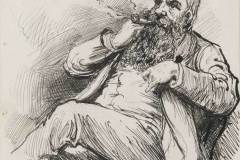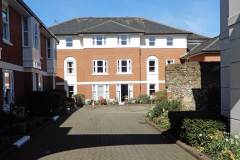(1832-1902) Prolific English journalist and children’s writer
Born near Cambridge, George Alfred Henty (styled GA Henty for all his writings) attended Westminster School and later Gonville and Caius College which he left in 1854 (before completing his degree) to join the army. After a period in the army, which included service in the Crimean War, and marriage to his first wife Elizabeth Finucane, he became bored with army life and resigned his commission. His wife bore him two daughters and two sons but, in 1865, died of tuberculosis.
His writing career started as a ‘special correspondent’ for The Standard newspaper. In this role, having left his young children to the care of his mother, he covered the Franco-Prussian War, the Garibaldi campaigns (when Henty was arrested as a spy and escaped), opening of the Suez Canal and the Dreyfus trial. During the next thirty years Henty published over 100 books, many of which were exciting adventure stories for children that proved extremely popular. Typical heroes (occasionally heroines) were young, resourceful, plucky, and modest. Most books extolled the benefits of The British Empire and some included views that would today be thought racist. Henty books became a popular choice as awards on School Prize Day. One estimate of the total number of Henty books sold suggests 25 million copies worldwide. Several notable historians, including AJP Taylor, acknowledged that the Henty books stimulated their initial interest in the subject. In 1889 Henty married his second wife, Elizabeth Keylock – she was 22 years his junior. He died on his yacht The Egret in Weymouth Harbour in 1902.
Readers may reasonably wonder what the above has to do with Canterbury. For the following explanation I am totally indebted to Stephen Williamson. Mr Williamson is a direct descendant of the Canterbury family which in 1936 generously donated Westgate Gardens for use by the public. The same family produced the city’s first female mayor, Catherine Williamson (mayor 1938-40). Stephen Williamson is author of an article which appeared in the Henty Society Bulletin. Authors of Henty biographies had mentioned Canterbury as Henty’s childhood home, but with no details of precisely where. The article analyses Henty’s very autobiographical novel ‘Search for a Secret’ (published in 1867) where the action is set in the Canterbury area. It contains this marvellous description of the house in Canterbury that Henty’s maternal grandfather, a medical doctor, moved to with his family in 1837/8:
I was not, as I have said, born in the town, but went there very young—so young that I have no remembrance of any earlier time.
We lived in a large, rambling, old-fashioned house in a back lane. In a little court before it stood some lime-trees, which, if they helped to make the front darker and more dismal than it would otherwise have been, had the good effect of shutting it out from the bad company into which it had fallen.
It had at one time been a place of great pretension, and belonged, doubtless, to some country magnate, and before the little houses in the narrow lane had sprung up and hemmed it in, it may have had a cheerful appearance; but, at the time I speak of, the external aspect was undeniably gloomy. But behind it was very different. There was a lawn and large garden, at the end of which the Stour flowed quietly along, and we children were never tired of watching the long streamer-like green weeds at the bottom waving gently in the current, and the trout darting here and there among them, or lying immovable, apparently watching us, until at the slightest noise or motion they would dart away too quickly for the eye to follow them.
Inside, it was a glorious home for us, with its great old-fashioned hall with dark wainscoting and large stags’ heads all round it, which seemed to be watching us children from their eyeless sockets; and its vast fireplace, with iron dogs, where, in the old days, a fire sufficient for the roasting of a whole bullock, might have been piled up; with its grand staircase, with heavy oak balustrades, lit by a great window large enough for an ordinary church; with its long passages and endless turnings and backstairs in unexpected places; with all its low, quaint rooms of every shape except square, and its closets nearly as large as rooms.
Oh, it was a delightful house! But very terrible at dusk. Then we would not have gone along alone those long, dark passages for worlds; for we knew that the bogies, and other strange things of which our old nurse told us, would be sure to be lurking and upon the watch.
It was a wonderful house for echoes, and at night we would steal from our beds and creep to the top of the grand staircase, and listen, with hushed breath, to the almost preternaturally loud tick of the old clock in the hall, which seemed to us to get louder and louder, till at last the terrors of the place would be almost too much for us, and, at the sound of some mouse running behind the wainscoting, we would scamper off to our beds, and bury our heads beneath the clothes, falling into a troubled sleep, from which we woke, with terrified starts, until the welcome approach of day, when, as the sun shone brightly in, we would pluck up courage and laugh at our night’s fright.
It concludes tht Henty lived in a substantial property that lay between Stour Street and the River Stour that later (1986) became the site for Mulberry House, residential sheltered housing.
Sources: DNB; Henty Society Journal (July 2016) No. 138); Canterbury Archaeological Trust 11th Annual Report 1986-87 p. 10


